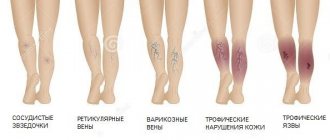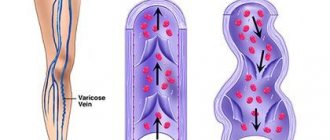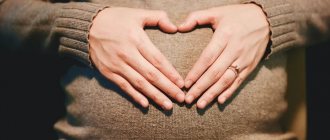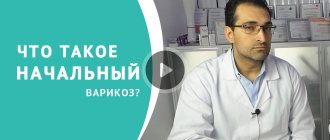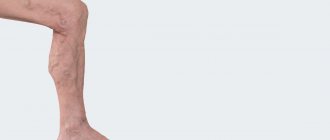Varicose veins of the lower extremities. Causes of the disease (Wikipedia and the official approach):
There are primary and secondary varicose veins of the lower extremities. Secondary develops as a result of injuries, tumors, etc., when the venous system cannot fully perform its functions.
Occupations in which varicose veins most often develop
Primary develops due to weakness of the venous wall. Reasons that contribute to the development of varicose veins of the lower extremities:
- pregnancy;
- hormonal imbalance;
- heavy static loads;
- smoking;
- work that requires standing for long periods of time (for example, hairdressers, salespeople, waiters);
- sitting in an incorrect position, especially crossing your legs;
- high-heeled shoes;
- sedentary lifestyle.
All these factors contribute to a deterioration in the outflow of blood from the lower extremities, thereby the superficial veins become overfilled, dilate, and blood stagnation occurs. Heredity plays an important role in the development of the disease.
From varicose veins to thrombosis - just a step: 5 important questions about the causes and dangers of varicose veins
How to understand when to go to the hospital, and what will happen if you don’t get treatment
It is necessary and possible to treat varicose veins before it is too late
Photo: “No varicose veins”
Today it is difficult to meet a person who has never felt heaviness in his legs or noticed a scattering of spider veins on his body. But, as a rule, no one thinks about what serious consequences these symptoms, familiar to many, can lead to. For example, to the formation of a blood clot, which at any moment can break away from the vessel wall and lead to a sad outcome.
That's why Thrombosis Day is celebrated around the world in October to once again remind people how insidious and dangerous this disease can be.
According to recent medical research, adult patients with varicose veins are five times more likely to develop deep vein thrombosis. Surgeon-phlebologist of the laser surgery clinic “No Varicose Veins” Grant Ambaryan answered the most popular questions about the treatment and prevention of varicose veins and how to prevent the occurrence of thrombosis.
Why are varicose veins dangerous?
Varicose veins are a disease accompanied by thinning of the venous wall and an increase in the lumen of the veins. Due to varicose veins, the risk of blood clots increases, skin diseases appear - itching, burning, eczema and even venous ulcers, that is, painful deep defects of the skin and fatty tissue. Bleeding may even occur because the dilated, thinned vessel wall is easily damaged.
“If treatment is not started in time, irreversible consequences will occur, including death,” says Dr. Ambaryan.
Photo: “No varicose veins”
Why do varicose veins appear?
The main reasons are a sedentary lifestyle or, conversely, heavy physical activity of a constant nature.
— Drivers and office workers spend a lot of time sitting, while loaders, hairdressers, salespeople, and factory workers, on the contrary, work on their feet all day. Both have a bad effect on vascular health,” says Grant Ambaryan. “In addition, varicose veins are more common in women, and high heels and heavy bags are partly to blame. And, of course, you should always take into account bad habits - smoking, alcohol, unhealthy diet.
Therefore, it is very important to regularly exercise without lifting weights, give up fatty and smoked foods, fast food, excessive amounts of sweets, soda, strong tea and coffee, and alcohol. Avoid wearing too tight clothes or uncomfortable high-heeled shoes. When resting in a horizontal position, your legs should be kept slightly higher than your torso. And, of course, get rid of excess weight and all addictions, especially tobacco.
How to understand that varicose veins have started?
If at the end of the day there is a feeling of heaviness in the legs, buzzing, tingling, numbness, burning, swelling, even just a trace from the elastic of socks, this already indicates a disruption in the exchange of fluid between tissues and blood vessels. Spider veins, discoloration of certain areas of the skin, noticeable outlines of large blue veins, cramps that occur during the day when walking or while resting are all reasons for an immediate visit to the doctor. And for preventive purposes, you need to visit a phlebologist once a year.
Photo: ru. depositphotos.com
What happens if varicose veins are not treated?
Most people who have the above symptoms do not attach much importance to them.
“When varicose veins appear on the legs, patients believe that it can be cured at any time and put off visiting the doctor,” says Dr. Ambaryan. “This is a very big misconception, since varicose veins and its consequences lead to serious complications and even death. For example, venous thrombosis may develop. In 80% of cases this happens gradually and secretly.
Often the disease is diagnosed after life-threatening complications develop. Thus, one patient of the “No Varicose Veins” clinic came for examination when she already had an advanced stage of varicose veins. For many years she ignored him. Doctors conducted an examination, did an ultrasound and noticed a blood clot. The patient was sent by ambulance to the hospital, where the blood clot was removed in time. If the woman had continued to delay her appeal, everything could have ended in tears.
How are varicose veins diagnosed and treated now?
The gold standard for diagnosing varicose veins is ultrasound, Dopplerography and angiography. These methods show the speed of blood flow and help determine its disturbance in individual vessels. Most often, this is enough for the doctor to make an accurate diagnosis.
At the moment, there are three ways to treat varicose veins. The conservative method is suitable for patients with the initial stages of the disease: it does not reverse the pathological process, but helps to partially eliminate the symptoms of the disease. Minimally invasive treatment - sclerotherapy and percutaneous laser coagulation - is used for the first and second stages of varicose veins. These methods are on the border between surgical and medicinal treatments.
The most effective outpatient methods for treating varicose veins in the middle and late stages are combined phlebectomy, endovasal laser coagulation and radiofrequency ablation of the great or small saphenous veins.
“Of course, it’s better not to bring the situation to surgical intervention, so you need to listen carefully to your body and get examined in time,” summed up Hrant Hambaryan.
Varicose veins of the lower extremities - symptoms
Varicose veins of the lower extremities are accompanied by the following symptoms:
- swelling of the legs at the end of the working day;
- feeling of heaviness in the legs;
- cramps in the calf muscles, mainly at night;
- pain, burning sensation in the legs;
- spider veins on the legs;
- formation of trophic ulcers.
Spider veins are small red-blue nodules on the skin that can be seen on the legs at the very beginning of the disease. Often, varicose veins of the lower extremities during pregnancy cause particular discomfort.
C4 stage of varicose veins
C4 – stage of appearance of trophic changes in the skin. These changes are called eczema. The skin in the area of varicose nodes darkens. The darkening can spread widely beyond the varicose veins. The skin is dry and may crack; very often patients with this form of the disease report itching, goosebumps, burning, tingling, distension and other forms of venous insufficiency. Another form of venous eczema is white skin atrophy, a condition where skin cells lose the ability to produce dark pigment due to their death and the skin becomes a mottled white color that can crack and form crusts. In some patients, on the contrary, the skin in the area of trophic changes is inflamed, red, and in the case of lymphostasis, it can become wet and crusty. Trophic eczema is a “pre-ulcerative” condition of the skin and, with minor changes or damage, easily passes into the next stage - a trophic ulcer (C6 or C5). Venous eczema is a rather complex problem. Its treatment requires significant effort on the part of both the doctor and the patient. Even despite the use of a wide arsenal of phlebological techniques, very often eczema is irreversible or poorly reversible and remains with the patient for life, requiring annual consultations with a doctor and supportive therapy.
The initial stage of eczema in the form of darkening (C4a)
“Weeping” eczema with crusts in a patient with C4 class of varicose veins according to CEAP
Varicose veins of the lower extremities - stages
There are several stages of disease development:
- compensation – spider veins and tortuous veins appear on the legs, no complaints
- subcompensation – there are complaints of swelling, cramps of the calf muscles, a feeling of heaviness, fatigue in the legs, pronounced dilated veins are visually determined
- decompensation – dermatitis, minor hemorrhages are added, the skin becomes dense, dry, easily wounded, pigment spots appear
The earlier the disease is detected, the easier it is to treat.
C0 and C1 stages of varicose veins
C0 means that the patient has no external manifestations of the disease, but if after C0 there is a small letter “s”, this means that there are symptoms characteristic of venous insufficiency, i.e. complaints of heaviness, pain, discomfort, cramps or other manifestations of the disease.
C1 - means that the main manifestations of varicose veins in the patient are spider veins or small dilated veins (reticular veins), with a diameter of up to 2-3 mm. At the same time, on large main veins, according to ultrasound scanning, there is usually no significant downward blood flow (after the letter “P” in CEAP there is an “n”). If we see the same letter “s” after C1, this means that in addition to asterisks there are symptoms of venous insufficiency. Most often, this is the stage of local (local) disturbances of venous hemodynamics at the level of microcapillaries, and at this stage, removal of “stars” is a cosmetic procedure.
C1 stage of varicose veins (spider veins)
Stage C1 – reticular vein and spider vein
Varicose veins of the lower extremities - diagnosis
To accurately diagnose the disease, you must consult a doctor. Vascular surgery deals with varicose veins of the lower extremities. To make a diagnosis, in addition to complaints and visual examination, it is necessary to use special research methods.
Ultrasound diagnosis of varicose veins of the lower extremities
Duplex angioscanning is considered the gold standard. This method combines ultrasound and Doppler scanning. Thus, it is possible to see the condition of the vascular wall in real time and assess the speed of blood flow in the venous system of the lower extremities.
Treatment:
On an outpatient basis, under tumescent (local) anesthesia, endovasal laser obliteration (EVLK) was performed using the German technology Biolitec v.saphena magna dextra . The duration of the procedure was about 30 minutes. 15 minutes later, after a follow-up examination by the operating surgeon-phlebologist, the patient left the clinic on his own.
Operating surgeon:
Rumyantsev A.Yu.
Assistant:
Voloshkin A.N.
The next day, an examination with ultrasound duplex scanning and dressing was performed.
Varicose veins of the lower extremities - complications
If there are varicose veins of the lower extremities, treatment should begin faster, otherwise the disease will progress, which is fraught with serious complications. Stagnation of blood in the veins contributes to the formation of blood clots, phlebothrombosis develops, and if the vein also becomes inflamed, thrombophlebitis develops.
Acute thrombophlebitis of superficial veins
The resulting blood clots can break free from their place at any time and enter the bloodstream. In this case, the blood clot enters the veins of the lungs, blocking them. In this case, a person can die from suffocation even before the ambulance arrives, because such a formidable complication is extremely difficult to treat even in a specialized hospital, and there is very little time to save a life.
In addition, due to blood stagnation, nutrition of the lower extremities is disrupted. Deep trophic ulcers form on the skin, which heal poorly and tend to spread. This can lead to amputation of the limb.
Based on the fact that complications of varicose veins of the lower extremities are not at all harmless, it is necessary to contact a qualified specialist as soon as possible. Only a doctor can prescribe effective treatment and help avoid complications.
C5 and C6 stages
C5 and C6 – stages of varicose veins with ulcerative lesions of the skin and subcutaneous tissue of the leg. C6 – open ulcer, C5 – healed ulcer. The appearance of a skin defect on the leg is very difficult and painful for the patient. In addition, a person has to constantly treat the skin so that suppuration does not occur, and the ulcerative defect itself is usually very painful. It is difficult for a person to wear clothes or shoes; every touch causes pain. If a person is young enough, the appearance of an ulcer on the leg greatly reduces social adaptation (he cannot go to the pool, bathhouse, or beach, and is forced to hide his illness).
An ulcerative defect reduces immunity, being an entrance gate for infection, it draws protective blood cells to fight bacteria that constantly penetrate the wound. A person is forced (wasted) to spend a lot of money on ointments, tablets, dressings, consultations with doctors in order to fight his ulcer, not suspecting that most ulcers can be successfully treated with modern methods! The problem is that no LOCAL treatment with ointments and creams can cure an ulcer if the cause of the disease is not eliminated. In the case of a venous ulcer, this cause is VARICOSIS. Without eliminating the problematic vein, through which venous blood constantly flows into the ulcer (WITH WASTE!!!), causing swelling of the ulcer surface and a huge concentration of waste harmful substances in the wound, the ulcerative defect will not heal! In addition, cases of malignancy of long-existing ulcerative defects (degeneration into ulcerative skin cancer) have been described.
Please note that the causes of trophic ulcers on the skin are a large number of diseases, such as severe atherosclerosis of the arteries of the legs, fungal or bacterial infections of the legs, high blood pressure (Martorell's ulcer), lymphostasis, previous erysipelas, obliterating endarteritis, deep vein thrombosis and postthrombophlebitis illness, as well as a number of others. The treatment of these diseases is very different, and in some cases directly opposite, to the treatment of venous trophic ulcers, and it is not recommended to treat the ulcerative defect on your own, without the supervision of a doctor, because for the above diseases, recommendations effective for the treatment of venous ulcers can greatly aggravate the condition of the ulcer caused by non-venous pathology!
Venous ulcer C6
Currently, the treatment of ulcerative venous defects is very effective using modern compression materials, the latest generation of dressings, as well as the most gentle method for eliminating varicose veins - endovenous laser obliteration.
Varicose veins of the lower extremities - how to treat with ointments
In the pharmacy you can find a huge number of ointments for varicose veins of the lower extremities. They are based on substances that improve tissue trophism, relieve swelling and strengthen the vascular wall. Varicose veins of the lower extremities, photos and reviews of ointments are available on the drug pages on the Internet.
Treatment of varicose veins with ointments and gels
In the early stages of the development of the disease, the use of various ointments can improve the condition of the venous system and slow down the progression of the disease, but it will not be possible to completely defeat varicose veins of the lower extremities. The results will be available only after visiting a doctor.
How common are varicose veins?
Varicose veins are one of the most common diseases of the vascular system. According to some statistical estimates, about a third of the total population of Western countries suffers from varicose veins. The number of people who have varicose veins increases with age, and women develop varicose veins much more often than men. According to statistics, in the age group under 25 years only 8% of women suffer from varicose veins, and in the older age group - from 55 years and older - signs of varicose veins are detected in 64% of women.
Varicose veins of the lower extremities - treatment: surgery or still a procedure?
- Intravascular coagulation. Do you have varicose veins of the lower extremities? Laser treatment in Moscow is a small endovascular operation during which a vein is obliterated with a laser. Varicose veins of the lower extremities will be removed; laser treatment is based on the introduction of blood flow into the desired vein. This is how varicose veins of the lower extremities are defeated. Laser treatment, the cost of which is not so high, takes little time and is well tolerated by patients, and they forget that they had varicose veins of the lower extremities; laser treatment (the price in our center is affordable) is very effective. The final figure depends on the stage of the disease and the amount of work the doctor does. Do not be afraid that varicose veins of the lower extremities will attack again later. Laser treatment (there are quite a lot of reviews!) will definitely put you “on your feet”!
- Short stripping is a minimally invasive technique in which a small section of the affected main vein is removed. In this way, it is possible to preserve as many healthy sections of veins as possible.
- Cryophlebectomy – removal of a vein using a cryoprobe. The operation is low-traumatic - however, one small incision is made to insert the probe. After the operation, you see results immediately.
C2 and C3 stages of varicose veins
C2 is the stage of appearance of varicose nodes or bumps on the legs. This is a serious stage of varicose veins, when a phlebologist diagnoses not only the presence of large dilated tributaries, but also, using ultrasound data, identifies a non-functioning main vein (one or more), which carries used blood not to the body for cleaning, but back to the leg (foot) . Treatment of this stage of varicose veins usually includes one or another surgical stage, which we will discuss below. The “gold standard” for the treatment of such veins today is endovenous laser obliteration (coagulation) in combination with procedures such as miniphlebectomy, as well as echopenic sclerotherapy of varicose tributaries.
C2 stage of varicose veins
C3 is the stage when varicose veins in the legs are accompanied by swelling. In such a situation, treatment of veins should be carried out comprehensively and include medications, compression therapy, surgical treatment (removal) of non-functioning veins, as well as long-term observation by a phlebologist.
C3 stage of varicose veins. Enlarged nodes and swelling of the lower leg
Varicose veins of the lower extremities - treatment with radiofrequency
How to remove varicose veins of the lower extremities? RFA treatment is of particular interest to patients. Why do many people dream of eliminating varicose veins of the lower extremities and prefer RFO treatment?
Radiofrequency ablation (RFA) is an operation that can be performed on an outpatient basis if you want to forget varicose veins of the lower extremities. RFA treatment in Moscow uses radio frequency, which is used to “seal” a vein and remove varicose veins of the lower extremities. RFO treatment in Moscow is fast and effective.
TREATMENT OF VARICOSE 1ST DEGREE
To avoid the development of the second stage of varicose veins, treatment should begin immediately. If there are risk factors, it is advisable to have your veins checked annually. Treatment of varicose veins of the 1st degree should have a comprehensive and systematic approach, while being individual in nature.
Patients are advised to wear compression garments. To improve the condition of the veins and stimulate healthy blood flow, both medications and physical procedures can be prescribed. Stage 1 varicose veins also respond well to treatment with external agents that penetrate deep into the tissues through the skin. Sclerotherapy and physical therapy have an excellent effect. However, without lifestyle correction, a complete cure is impossible.
Caution - varicose veins of the lower extremities
Treatment with traditional methods (prices for herbs and creams differ), but still do not place too much hope on a green pharmacy.
Excess weight provokes the development of varicose veins
It is important to pay attention to nutrition if you have varicose veins of the lower extremities, treatment with traditional methods, the price of which is pennies. It is necessary to limit the consumption of meat, spicy, salty and smoked foods, increase the amount of vegetables and fruits in the diet and eliminate alcohol and coffee.
An optimal daily routine and therapeutic exercises will help improve blood circulation in the extremities. This will take 10-15 minutes a day.
Simple traditional methods of treatment can complement the complex of measures for the treatment of varicose veins. Rubbing the feet with horse chestnut tincture, apple cider vinegar, butter with garlic and many other remedies have been known since ancient times. They will ease varicose veins of the lower extremities, the cost, photos and results can be viewed on our website on the Internet.
Are spider veins also a manifestation of varicose veins?
Spider veins are clusters of thin, purple or red thread-like vessels that appear around the knees or ankles. Sometimes such vascular “webs” can appear on the face, near the nose. These vessels cannot be called varicose veins, by definition. In fact, these are slightly dilated venules (vessels connecting capillaries to the veins themselves), which are located close to the surface of the skin.
Such dilated venules appear due to increased levels of female sex hormones in the blood and are often found in women taking oral contraceptives. But venules can expand even in the presence of varicose veins of larger veins that do not appear externally.
Varicose veins of the lower extremities - prevention
For prevention, it is necessary first of all to adhere to the work regime. You cannot constantly be on your feet or sit in one position. From time to time it is worth taking short breaks to give your legs a rest.
After a hard day at work, you can massage your feet, after which it is advisable to put your feet on a raised platform. This improves blood flow from the extremities.
Exercises to improve venous blood flow in the legs
Don't get carried away with hot baths and saunas. To prevent varicose veins, it is much more useful to take a contrast shower and rinse your legs with cool water.
It is important to monitor your weight. Excess body weight increases the load on the venous system and contributes to the development of the disease.
If there is a predisposition to developing the disease, and it is not possible to eliminate all risk factors, it is better to engage in prevention. Even if the disease has already begun, do not despair. Varicose veins of the lower extremities are not a death sentence. By detecting the problem in a timely manner and contacting specialists, you can get rid of the disease and avoid serious complications.
We invite you to visit our specialist phlebologist and get rid of varicose veins in the early stages.
Other causes of varicose veins
Such a wide prevalence of varicose veins in highly developed countries is certainly associated, among other things, with the lifestyle of the population. For example, we spend a lot of time sitting on chairs. From kindergarten until graduation, a person sits for at least 40 hours a week (counting approximately 5 hours during the day in class, 3 hours in the evening doing homework, watching TV, and so on - 5 days a week). Now let's multiply these hours by 10 months a year, and so on - up to 17 years. Then - work in some institution where you have to sit even longer. When a person sits in a chair, the veins running along the back of the thighs are compressed, and the calf muscles (the rhythmic contractions of which help move venous blood to the heart) do not work.
Another important factor is nutrition. In Western countries, people prefer a low fiber diet. With such a diet, there is a high tendency to constipation. Which also has an extremely negative impact on the condition of the venous valves and contributes to varicose veins.
Frequently asked questions from our patients on the Internet about varicose veins of the lower extremities
Are varicose veins of the lower extremities dangerous during pregnancy? Anastasia from Belgorod is interested in:
Dear Anastasia! Varicose veins of the lower extremities during pregnancy carry certain risks of developing thromboembolic complications. Therefore, it is necessary to contact a phlebologist and follow his recommendations.
I have had varicose veins of the lower extremities for quite a long time, what surgery is best? Tamara from Ufa asks:
Dear Tamara! If you have varicose veins of the lower extremities, modern minimally invasive surgery will be optimal. The best methods today are thermoobliteration techniques (laser and radio frequency).
I was diagnosed with varicose veins of the lower extremities, how is the operation performed? Boris from St. Petersburg is interested in:
Dear Boris! You have been diagnosed with varicose veins of the lower extremities, and therefore surgery is indicated. In Russia there is no uniform approach to the choice of surgical treatment. There is a classic and outdated phlebectomy technique, with incisions and anesthesia. This operation is usually performed in public hospitals. In specialized phlebological centers, innovative techniques are used through puncture approaches (punctures). Such operations are performed on an outpatient basis, under local anesthesia, without incisions or pain.
Varicose veins of the lower extremities, what is it? Elena from Pskov is interested in:
Dear Elena! Varicose veins of the lower extremities are a chronic progressive disease, manifested by pathological dilation of venous vessels, disruption of the normal functioning of vein valves, which adversely affects blood flow. This condition often develops in people whose work and lifestyle are associated with prolonged static load.
Varicose veins of the lower extremities, what treatment is used? Natalya from Petrozavodsk is interested in:
Dear Natalia! When a diagnosis is made: varicose veins of the lower extremities, a fairly varied treatment is used. The conservative approach has many supporters, both among patients and doctors. But we must immediately clarify that treatment of varicose veins of the lower extremities cannot only be conservative. Modern treatment of varicose veins involves the use of innovative techniques that radically eliminate the pathology. You can see reviews from patients of our clinic on our website:
Is varicose veins inherited?
Varicose veins are definitely hereditary. Scientists even believe that they have been able to isolate a separate gene responsible for the development of varicose veins. It is not yet clear whether this gene causes malformations of the venous valves or malformations of the vein walls themselves.
There is no doubt that these studies will help develop a gene therapy technique - perhaps the most promising way to prevent and treat varicose veins. Unfortunately, this is still a matter of the rather distant future, and gene therapy is not yet available to patients with varicose veins.
Prevention
In order not to feel what varicose veins are, we recommend following simple rules:
- alternate work and rest;
- limit physical activity and standing work;
- exclude visiting saunas and baths;
- switch to a healthy lifestyle;
- promptly contact a phlebologist when you notice the first symptoms of varicose veins;
- exercise therapy.
Read more in the article How to strengthen the walls of blood vessels. Prevention of varicose veins.
Venous trophic ulcer
A venous ulcer is classified as a chronic wound that occurs with a long history of varicose veins and has no tendency to heal. This occurs due to severe structural tissue damage due to impaired venous outflow.
Venous ulcers are caused by long-term chronic venous insufficiency.
V stage of varicose veins: trophic ulcer
Blood pools and stagnates in your legs because defective valves in the veins prevent adequate blood return to the heart.
Symptoms of leg ulcers:
- Painful open wounds on the legs or ankles.
- Itching sensations in the lower extremities.
- Discharge of yellow or green fluid from the ulcer.
- Swelling of the legs.
- Change in skin color around the ulcer.
- Pain in the area of the ulcer.
- Feeling of heaviness in the lower extremities.
Venous trophic ulcers account for up to 80% of all ulcers of the lower extremities. In the vast majority of cases, patients can be helped using modern technologies for treating varicose veins. Yes, most of them are treated. It is enough to contact a good phlebological center in Moscow and a competent specialist.
Many of the listed symptoms and complications of varicose veins are hereditary, so if you have family members with chronic vein disease and you experience any of these symptoms, you are definitely at risk. Factors such as obesity, diet, smoking and alcohol consumption can also have a detrimental effect on the health of your feet.
Compression garments for varicose veins
In the early stages and after treatment, men are recommended to wear compression garments, which are selected individually. Anti-varicose underwear is similar in appearance to classic underwear, but there are no seams. The fabric consists of nylon, microfiber and lycra. The fabric is breathable and pleasant to the touch.
Compression jersey for men is divided into:
- stockings for varicose veins of the thighs,
- tights if both legs are affected,
- knee socks if the disease is on the calves or just above the knee.
You need to purchase underwear at the first sign of the disease.
Tips for wearing compression stockings:
- Put on your underwear carefully so as not to tear the product.
- File your fingernails and toenails to avoid tearing your underwear.
- Put it on in the morning, without waiting for swelling.
- Remove compression garments before going to bed.
- If it is difficult for an overweight patient to put on compression garments on their own, it is recommended to purchase a device for putting them on.
- Wash clothes in warm water with baby soap. To prevent water from getting on the silicone, tighten the upper part with thread, and clean the elastic band with a cotton pad in alcohol.
Device for putting on compression garments.
Diagnosis of varicose veins in men
The best solution for men with symptoms of varicose veins in Moscow is to contact a good phlebologist. The leading phlebologist in Moscow will always perform an ultrasound scan during consultation. Only this approach meets modern European standards. The expert examination will take no more than half an hour, and you will receive complete information about your venous system. The study does not involve any trauma and is performed entirely on an outpatient basis. Timely data obtained are extremely important for choosing innovative treatment, which will avoid complications and progression of the disease.


